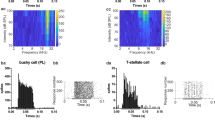Abstract
Tactile reception in cyprinid fish (silver crucian carp Carassius auratus gibelio and common carp Cyprinus carpio) was investigated by noninvasive recording of action potentials from the head skin in response to rhythmic tactile stimulation. Responses shaped as electric potentials following synchronously with changes in the pressure force on the skin were recorded using chloro-silver electrodes. It was shown that fish, like all terrestrial vertebrates, have phasic and tonic tactile receptors. Three main types of tactile responses were distinguished: (1) tonic responses as potential fluctuations repeating the dynamics of the tactile stimulus, (2) phasic responses as on-, off-, and on-off potentials, and (3) slow deflections from the resting potential. Compound responses comprising simultaneously different types of responses were also recorded. The response latency averaging 6.1 ms for tonic and 4.4 ms for phasic responses was clearly independent of the stimulus direction (switch-on, switch-off). The threshold level of tactile sensitivity in the perioral and gular head areas was 0.05–0.2 g/mm2. Tactile receptors on the silver crucian carp and common carp heads exhibited zonal distribution patterns, with sensory areas differing in their tactile sensitivity. Most sensitive areas were on the upper and lower lips, in the perilabial skin and the gular area on the ventral side of the head. Less sensitive areas were situated rostrally and ventrally to the eyeball. The areas situated dorsally and caudally to the eyeball proved to be insensitive to the applied tactile stimulation. In all sensory areas on the fish head, most intense responses were evoked by sliding tactile stimuli. The distribution specificity of tactile sensory areas meets their functional significance for fish feeding behavior.






Similar content being viewed by others
REFERENCES
Protasov, V.R., Povedenie ryb (Fish Behavior), Moscow, 1978.
Pavlov, D.S. and Kasumyan, A.O., Sensory base of food behavior in fish, J. Ichthyol., 1990, vol. 30(5), pp. 720–732.
Suvorov, E.K., Osnovy ikhtiologii (Fundamentals of Ichthyology), Leningrad, 1948.
Tan, D., Patton, P., and Coombs, S., Do blind cave fish have behavioral specializations for active flow-sensing, J. Comp. Physiol., 2011, vol. 197A, pp. 743–754. doi 10.1007/ s00359 011 0637 6
Ilyinsky, O.B., Voprosy fiziologii sensornykh system, Mekhanoretseptory (Problems of Physiology of Sensory Systems, Mechanoreceptors), Leningrad, 1967.
Kasumyan, A.O., Tactile reception and behavior of fish, J. Ichthyol., 2011, vol. 51(11), pp. 1035–1103. doi 10.1134/S003294521111004X
Smith, C., Biology of Sensory Systems, John Willey and Sons, 2005.
Pavlov, D.S., Biologicheskie osnovy upravleniya povedeniem ryb v vodnom potoke (Biological Basis of Fish Behavior Control in a Water Flow), Moscow, 1979.
Marui, T., Caprio, J., Kiyohara, S., and Kasahara, Y., Topographical organization of taste and tactile neurons in the facial lobe of the Sea Catfish, Plotosus lineatus, Brain Res., 1988, vol. 446, pp. 178–182. doi 10.1016/0006-8993(88)91312-1
Belousova, T.A., Devitsina, G.V., and Malyukina, G.A., Functional peculiarities of fish trigeminal system, Chem. Senses, 1983, vol. 8(2), pp. 121–130.
Pusdrowsky, R.L., Afferent projection of the trigeminal nerve in the goldfish, Carrasius auratus, J. Morphol., 1988, vol. 198, pp. 131–147.
Chervova, L.S. and Lapshin, D.N., The Effect of olfactory deprivation on the thresholds of sensitivity of skin chemoreceptors of carp Cyprinus carpio, J. Ichthyol., 2010, vol. 50(11), pp. 1030–1035. https://doi.org/10.1134/S0032945210110081
Devitsina, G. V. and Lapshin D.N., Tactile reception in the outer head cover of a goldfish (Carassius auratus gibelio), Dokl. Biol. Sci., 2016, vol. 466, pp. 21–23. doi 10.1134/S0012496616010075
Lekarstvennye preparaty v Rossii, Spravochnik (Medicinal Preparations in Russia. Formulary), Moscow, 2015.
Devitsina, G.V. and Golovkina, T.V., Structural organization of the taste apparatus in characins (Characidae, Teleostei), J. Ichthyol., 2018, vol. 58(1), pp. 59–72. doi 10.1134/S0032945218010046
Appelbaum, S. and Riehl, R., Scanning electron microscopic observation of the chemo- and mechanoreceptors of carp larvae (Cyprinus carpio) and their relationship to early behavior, Aquat. Liv. Resour., 1997, vol. 10, pp. 1–12. https://doi.org/10.1051/alr:1997001
Whitear, M., The free nerve endings in fish epidermis, J. Zool. London, 1971, vol. 163, pp. 231–236.
Harris, G.G., Frishkopf, L.S., and Flock, A., Receptor potentials from hair cells of the lateral line, Science, 1970, vol. 167(3914), pp. 76–79. doi 10.1126/science.167.3914.76
Krouse, A.B.A., van der Zalm, J.M., and van den Bercken, J., Extracellular receptor potentials from the lateral-line organ of Xenopus laevis, J. Exp. Biol., 1980, vol. 86, pp. 63–77.
Poulet, J.F.A. and Hedwig, B., The cellular basis of a corollary discharge, Science, 2006, 27(311): 518–522. doi 10.1126/science.1120847
Poulet, J.F.A. and Hedwig, B., New insights into corollary discharges mediated by identified neural pathways, Trends Neurosci., 2007, vol. 30(1), pp. 14–21. doi 10.1016/j.tins.2006.11.005
Lapshin, D.N. and Lukyanitsa, A.A., Neural network model of signal extraction from a complex sensory flow containing self-generated noise, Sens. Sist., 2012, vol. 26(1), pp. 69–75.
Devitsina, G.V., Adaptive variability of the gustatory system receptor part of the carp, Cyprinus carpio (Cyprinidae, Teleostei) after chronic anosmia, J. Evol. Biochem. Physiol., 2006, vol. 42(6), pp. 743–750. https://doi.org/10.1134/S0022093006060111
Herrick, C.J., On the centers for taste and touch in the medulla oblongata of fishes, J. Comp. Neurol. Psychol., 1906, vol. 16, pp. 403–439.
Funding
This work was supported by the program “Leading Scientific Schools” (SS–2666.2014.4) and the Moscow State University’s program “Truth” (section no. 0708), as well as by the research program of the Kharkevich Institute for Information Transmission Problems (Russian Academy of Sciences, Moscow) (no. 0061-2016-0012).
Author information
Authors and Affiliations
Corresponding author
Rights and permissions
About this article
Cite this article
Devitsina, G.V., Lapshin, D.N. A Noninvasive Electrophysiological Investigation of Tactile Sensitivity in Cyprinid Fish (Cyprinidae). J Evol Biochem Phys 56, 338–347 (2020). https://doi.org/10.1134/S0022093020040055
Received:
Revised:
Accepted:
Published:
Issue Date:
DOI: https://doi.org/10.1134/S0022093020040055



